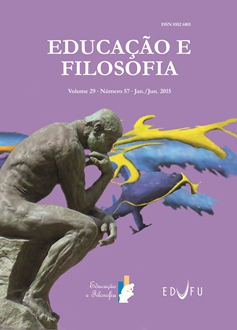David Hilbert e o axioma de Arquimedes: entre a geometria e a física
DOI:
https://doi.org/10.14393/REVEDFIL.issn.0102-6801.v29n57a2015-p343a379Palavras-chave:
Hilbert. Axioma de Arquimedes. Geometria. Física.Resumo
*Doutor em Lógica e Filosofia da Ciência pela Unicamp. Professor no Instituto de Filosofia da Universidade Federal de Uberlândia (UFU).
David Hilbert e o axioma de Arquimedes: entre a geometria e a física
Resumo: A relação entre geometria e física na obra de Hilbert é analisada através do caso do Axioma de Arquimedes. Começando com as questões geométricas e as formais, em particular a definição de modelos não arquimedeanos para provar a independência, passa-se logo à concepção de Hilbert da geometria como uma ciência empírica, para depois estudar a afirmação de Hilbert de que o Axioma de Arquimedes deve ser testado empiricamente. Nesse sentido, esse autor enuncia uma formulação empírica do axioma, a qual, segundo afirma, deveria ser submetida à experimentação. Tal enunciado coloca três tipos de questões. Primeiro, se é realmente um enunciado empírico ou se é um princípio metodológico que não pode ser testado. Segundo, se é uma interpretação adequada desse axioma. Por último, como poderiam ser idealiÂzados testes a partir desse enunciado. Sendo as primeiras questões problemáticas, pior é o caso da terceira, pois resulta difícil conceber experimentos bem definidos nos quais a formulação empírica possa ser testada, diferente, por exemplo, do caso da medição dos ângulos de um triângulo entre três picos encomendada por Gauss. Na estudo da formulação empírica também são analisados os comentários de Leo Corry e de Michael Stöltzer sobre o assunto, resultando em questionamentos sobre sua adequação e verificabilidade. Além disso, é salientada a importância de diferenciar os conceitos de mensuração, próprio do Axioma de Arquimedes, e de continuidade no sentido definido por Dedekind, baseado fundamentalmente na crítica que Sommer faz a Hilbert.
David Hilbert e o axioma de Arquimedes: entre a geometria e a física
Abstract: The relationship between geometry and physics in the work of Hilbert is analyzed through the case of the axiom of Archimedes. Starting with geometrical and formal issues (in particular, the definition of non-Archimedean models used for proving its independence), following with Hilbert conception that the physics is an empirical science, finally it is studied the Hilbertian statement that the axiom must be empirically confirmed. In this sense, he conceives an empirical statement of the axiom which must be confirmed by experiment. This statement arises three kind of questions. First, whether it actually is an empirical statement or a methodological rule which is not able to test. Second, whether it is a suitable interpretation of the axiom. Third, how can be created tests in relation to the empirical statement. Besides the fact that the two initial questions are difficult, the case of the third is worst, because, as far as I know, nobody proposed such a test, i.e. how can be designed well defined experiments to confirm the empirical statement (different, for example, of the case of the measurement of the sum of the angles of a triangle, performed by Gauss). The criticisms of Leo Corry and Michael Stöltzer are analyzed too, in particular the questions about adequacy and verification of the empirical statement. Furthermore, it is emphasized the relevance of the distinction between the concepts of measurement, inherent to the Archimedean axiom, and the one of the continuity (in Dedekind's sense), based upon the criticism of Sommer on the Foundations of Geometry of Hilbert.
Keywords: Hilbert. Axiom of Archimedes. Geometry. Physics.
Data de registro: 11/10/2013
Data de aceite: 23/04/2014
Referências:
ARNOLD, V. I. Mathematics and physics. In: BONIOLO, G.; BUDINICH, P.; TROBOK, M. (Ed.). The role of mathematics in physical sciences, Dordrecht: Springer, p. 225-233, 2005. https://doi.org/10.1007/s00220-005-1300-2
BERKELEY, G. The analyst: a discourse addressed to an infidel mathematician. Whitefish: Kessinger, 2004.
BIRKHOFF, G.; MACLANE, S.A survey of modern algebra. New York: MacMillan, 1965.
BOYER, C. B.; MERZBACH, U. C. A history of mathematics. 2. ed., New York: John Wiley & Son, 1991.
CANTOR, G. Gesammelte Abhandlungen mathematischen und philosophischen Inhalts . Berlin: Springer, 1932.
CARRIER, M. Geometric facts and geometrie theory: Helmholtz and 20th-century philosophy of physical geometry. Berlin: Akademie Verlag, p.276-291, 1994.
CORRY, L. David Hilbert and the axiomatization of physics (1898-1918): from Grundlagen der Geometrie to Grundlagen der Physik. Dordrecht: Kluwer, 2004.https://doi.org/10.1007/978-1-4020-2778-9
______. Axiomatics, empiricism, and anschauung in Hilbert's conception of geometry: Between arithmetic and general relativity. In: FERREIRÓS, J.; GRAY, J. J. (Ed.). The architecture of modern mathematics. Essays in History and Philosophy, p. 133-156, Oxford: Oxford University Press, 2006.
______. The origin of Hilberts axiomatic method. In: RENN, J.; SCHEMMEL, M. (Ed.). Theories of gravitation in the twilight of classical physics: the promise of mathematics and the dream of a unified theory, n.4, p. 759-855, Dordrecht: Springer, 2007.
DAUBEN, J. W. Georg Cantor: his mathematics and philosophy of the infinite. Princeton: Princeton University Press, 1990.
DEDEKIND, R. Stetigkeit und irrationale Zahlen, v. 3, Braunschweig: Friedr. Vieweg & Sohn, p. 315-334, 1932.
______;WEBER, H. (Ed.). Gesammelte mathematische Werke und wissenschaftlicher Nachlass. Leipzig: B. G. Teubners, 1876.
ENRIQUES, F. Prinzipien der Geometrie. Leipzig: Teubner, 1907.
EUCLID. Elements. Lulu.Com. Texto grego com tradução inglesa, 2007.
EWALD, W. From Kant to Hilbert: a source book in the foundations of mathematics, v. 2. New York: Oxford University Press, 1996.
GÖDEL, K. Remark on non-standard analysis. In: FEFERMAN, S. (Ed.). Collected works II, n. 2, New York: Oxford University Press. p. 759-855, 1990.
GRAY, J. Gauss and non-Euclidean geometry. New York: Springer, p. 61-80, 2006. https://doi.org/10.1007/0-387-29555-0_2
HEATH, S.; HEIBERG, J. The thirteen books of Euclid's elements. Cambridge: Cambridge University Press, 1908.
HENSEL, K. Über eine neue Begründung der Theorie der algebraischen Zahlen. Jahresbericht der Deutschen Mathematiker-Vereinigung, v. 6, n. 3, p. 83-88, Jul. 1897.
HILBERT, D. (1899). Grundlagen der Geometrie. In Festschrift zur Feier der Enthüllung des Gauss-Weber-Denkmals in Göttingen. I. Theil. B. G. Teubner, Leipzig, 1 edition.
______.Grundlagen der Geometrie. 2. ed., Leipzig: B. G. Teubner, 1903.
______. Axiomatische Denken, v.3, Berlin: Springer, p. 146-156, 1935a. https://doi.org/10.1007/978-3-662-38452-7_10
______. Gesammelte Abhandlungen III. Berlin: Springer, 1935b.
______.David Hilbert's Lectures on the Foundations of Physics, 1915-1927: Relativity, Quantum Theory and Epistemology. Dordrecht: Springer-Verlag, 2006.
HRBACEK, K.; JECH, T. Introduction to set theory. 3. ed., New York: Marcel Dekker, 1999.
MAJER, U. Hilbert's axiomatic approach to the foundations of science - a failed research program? In: HENDRICKS, V. F.; JØRGENSEN, K. F.; LÜTZEN, J.;PEDERSEN, S. A. (Ed.). Interactions — Mathematics, Physics and Philosophy, 1860-1930, v. 251, p. 155-183. Dordrecht: Springer, 2006. https://doi.org/10.1007/978-1-4020-5195-1_5
MOISE, E. E. Elementary geometry from an advanced standpoint. 3. ed., Massachusetts: Addison-Wesley, 1990.
POINCARÉ, H. Science and hypothesis. New York: Walter Scott, 1905.
RAMAL, R.; TOULOUSE, G.; VIRASORO, M. Ultrametricity for physicists. Reviews of Modern Physics, v. 58, n. 3, p. 765-788, Jul. 1986. https://doi.org/10.1103/RevModPhys.58.765.
ROBINSON, A. Non-standard analysis. Princeton; Princeton University Press, 1996.
ROWE, D. The calm before the storm: Hilbert's early views on foundations. In: HENDRICKS, V. F.; LÜTZEN, J.; PEDERSEN, S. A.; JØRGENSEN, K. F. (Ed.). Proof theory: history and philosophical significance, of Synthese Library. Studies in Epistemology, Logic, Methodology and Philosophy of Science, v. 292, p. 55-93. Dordrecht: Kluwer, 2000. https://doi.org/10.1007/978-94-017-2796-9_4
RUDIN, W. Principles of mathematical analysis. 3. ed., New York: McGraw-Hill, 1976.
SCHEINERMAN, E. Matemática discreta- uma introdução. São Paulo: Thomson Learning, 2006.
SOMMER, J. Hilbert's foundations of geometry. Bulletin of the American Mathematical Society (New Series), v. 6, n. 7, p. 287-299, Abr. 1900. https://doi.org/10.1090/S0002-9904-1900-00719-1
STÖLTZNER, M. How metaphysical is 'deepening the foundations' — Hahn and Frank on Hilbert's axiomatic method. History of Philosophy of Science. New Trends and Perspectives, v. 55, n. 3, p. 245-262, 2002.
TOEPELL, M. The origins and the further development of Hilbert Ìs "Grundlagen der Geometrie". Le Matematiche, v. 55, n. 3, p. 207-226, 2000.
TORRETTI, R. La geometria del universo. Mérida: Universidad de los Andes - Consejo de Publicaciones, 1994.
VERONESE, G. Grundzüge der Geometrie von mehreren Dimensionen und mehreren Arten gradliniger Einheiten in elementarer Form entwickelt. Leipzig: Teubner, 1894.
Downloads
Downloads
Publicado
Como Citar
Edição
Seção
Licença
Declaração de direitos autorais: Os trabalhos publicados são de propriedade dos seus autores, que poderão dispor deles para posteriores publicações, sempre fazendo constar a edição original (título original, Educação e Filosofia, volume, nº, páginas). Todos os artigos desta revista são de inteira responsabilidade de seus autores, não cabendo qualquer responsabilidade legal sobre seu conteúdo à Revista ou à EDUFU.
Declaration of Copyright: The works published are the property of their authors, who may make use of them for later publications, always citing the original publication (original title, Educação e Filosofia, volume, issue, pages). The authors of the articles published are fully responsible for them; the journal and/or EDUFU are exempt from legal responsibility for their content.
Déclaration de droit d’auteur: Les œuvres publiées sont la propriété de leurs auteurs, qui peuvent les avoir pour publication ultérieure, à condition que l'édition originale soit mentionnée (titre de l'original, Educação e Filosofia, volume, nombre, pages). Tous les articles de cette revue relèvent de la seule responsabilité de leurs auteurs et aucune responsabilité légale quant à son contenu n'incombe au périodique ou à l’EDUFU.



